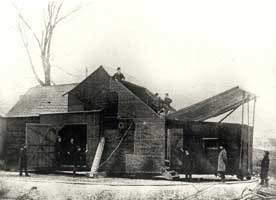
NPS Photo Sometimes one invention might give you an idea for making something else. That is what happened to Thomas Edison with motion pictures. In October 1888 Edison wrote, "I am experimenting upon an instrument which does for the Eye what the phonograph does for the Ear . . ." Actually, "motion" pictures only seem to move. A modern movie camera takes still pictures like a regular camera does. However, it takes 24 of these pictures, or frames, per second. When you show these pictures at a very fast rate, they look like they are moving. Even before Edison's work on movies, this basic idea had already been developed by a British photographer named Eadward Muybridge. He wanted to prove that when a horse ran, all four of its legs could be up in the air at once. By taking several photos very fast, Muybridge proved his point. Around 1889 Edison picked a team of muckers to work on this project, headed by William Kennedy Laurie Dickson. They built the Strip Kinetograph, which was a very early movie camera. The "strip" was a piece of long, flexible film that had been invented for regular camera. Unlike older photographic film, it could be wrapped around a wheel or a spool. The Strip Kinetograph took pictures so fast that they would seem to move. Then Edison and his muckers built a Kinetoscope, a machine to watch these movies. One person at a time would pay five cents to watch a short, silent movie about twenty to thirty seconds long. The first kinetoscope parlor, or movie theater, opened on April 14, 1894, at 1155 Broadway in New York City. To film these movies, the muckers needed a stage. Edison's light bulbs were not bright enough to make these films. They built a stage out of wood planks and tar paper, with a roof that opened up to the sun. This strange building looked a little like a police wagon or a hearse (which took coffins to the graveyard). A police wagon was sometimes called a "black Maria" (pronounced Ma-RI-uh). This "Black Maria" was built in 1893. Short films were made there for ten years until it was torn down around 1903. By then Edison had a newer, better movie studio in New York City. Edison was one of the inventors of motion pictures, but he should not get all the credit. Other inventors in different parts of the world made important discoveries as well. For just one example, in 1896 Thomas Armat and Francis Jenkins designed the phantascope. This early movie projector showed the film onto a screen, so that a roomful of people could watch at the same time. Edison bought the rights to this machine and started making his own projectors. The Lumiere brothers in France were also extremely important in the development of movies. Other inventors also helped find pieces of the puzzle. But, with his huge laboratory here in West Orange, Edison put the pieces of the puzzle together. That is why he is sometimes called the "Father of Motion Pictures."
Back to Phonograph For Kids |
Last updated: February 26, 2015
